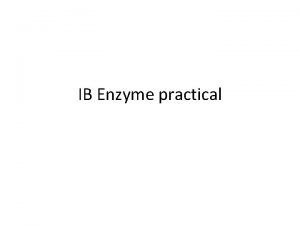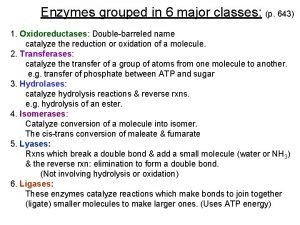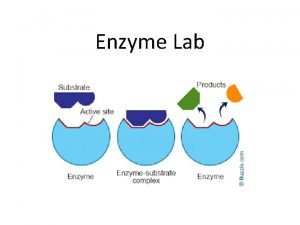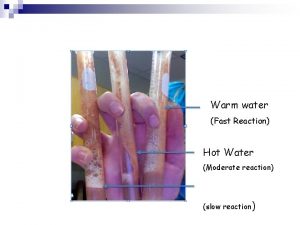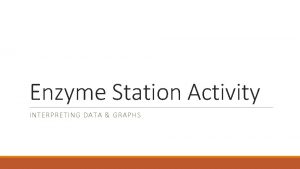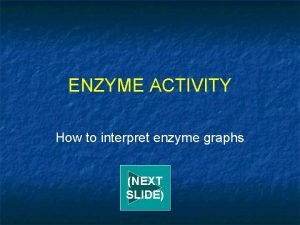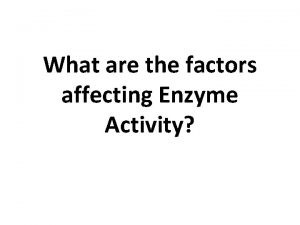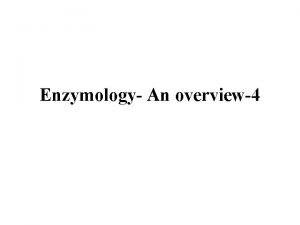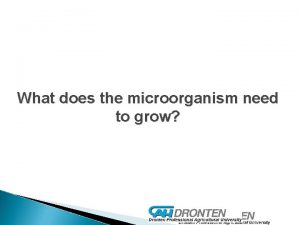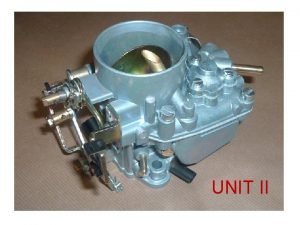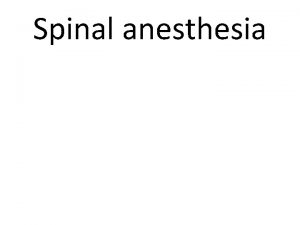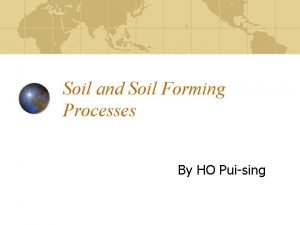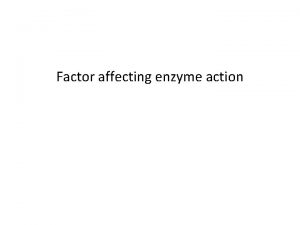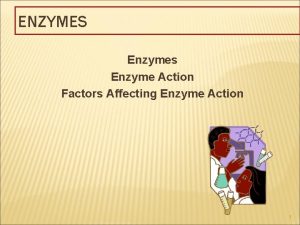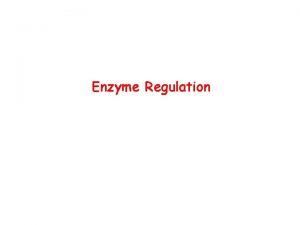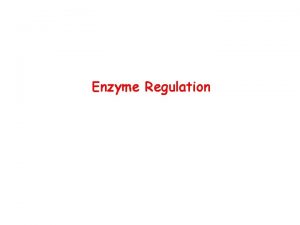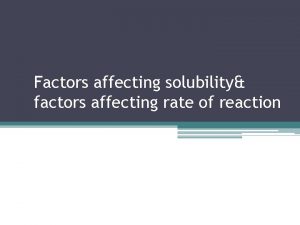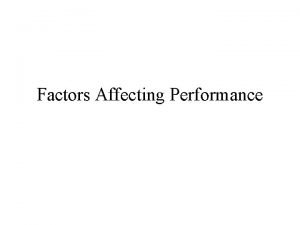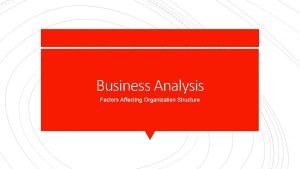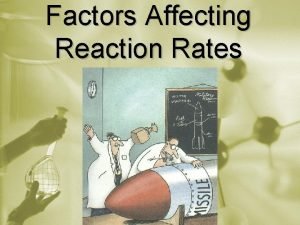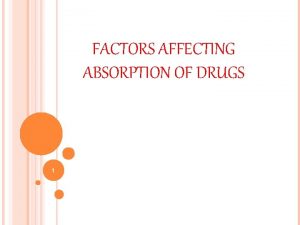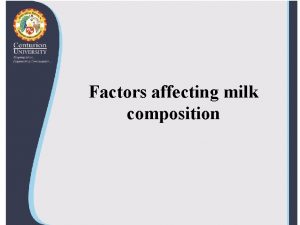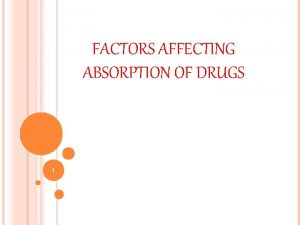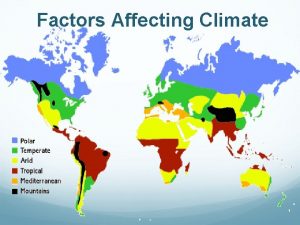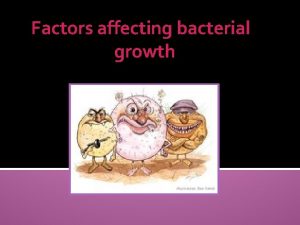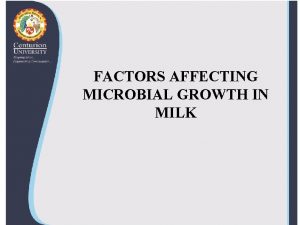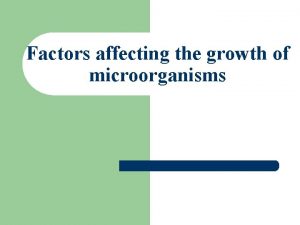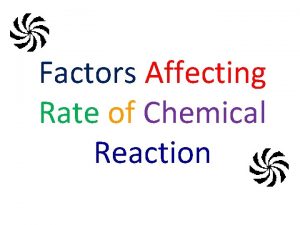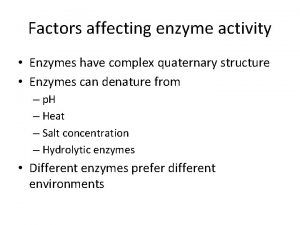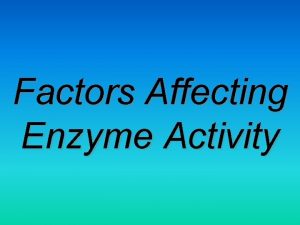Enzyme 3 Factors affecting enzyme activity Lecture NO























- Slides: 23

Enzyme -3. Factors affecting enzyme activity Lecture NO: 1 st MBBS Dr Muhammad Ramzan

Enzyme activity - the definition • Enzyme activity refers to the catalytic ability of an enzyme • to increase the rate of a chemical reaction. • Turnover No: is the maximum number of molecules of substrate that an enzyme : • Can convert to products per catalytic site/ mint. • www. wikipedia. com – www. medical-dictionary. com

Michaelis-Menten equation • It is a set of mathematical expressions to calculate enzyme activity in terms of speed of reaction from measurable laboratory data.

Michaelis Menten equation

Conclusion of the equation • Characteristic of Km: It reflects the affinity of the E with S • Is equal to the Conc. of S at which reaction velocity is equal to ½ Vmax. Km does not vary with the conc. Of E • It is important in competitive inhibition when ↑ in S reverses the Vmax as inhibitor is diluted • Vmax: is achieved when all the active sites of E are occupied by the S • Vmax: Cannot be achieved in Non completive inhibition as inhibitor binds either to E or ES Complex. • ↑in S has no effect as it cannot bind to active site

Enzyme assay – measure E activity Carbonic Anhydrase – 36 million. S/mint • Enzymes assay is the laboratory method for measuring the enzyme activity- vital for E kinetics/inhibition • It measures either the disappearance of Substrate or appearance of products overtime • Carbonic Anhydrase is the enzyme having highest Turn Over NO: at 36 million moles per minute. (bicarbonate) • More common NOs: are closer to 1000 moles/minute • www. chem. libretext. org – www. wikipedia. com

Activity of Carbonic Anhydrase

Factors affecting the enzyme activity Temperature and p. H • Although Es speed up chemical reactions, each E works most efficiently under a specific set of conditions. • Because almost all enzymes are proteins, any factor that affects the shape of a protein, may affect E activity • High temperature and hostile p. H are the major factors affecting the activity of the enzymes

Factors affecting enzyme activity the list of 5 • • • These factors are : Temperature p. H of the solution Concentration of substrates and that of enzymes Activators or inhibitor molecules

Enzyme activity and temperature (temp. ) ↑es interaction B/w E and S • Temp. /heat is a sort of energy present in the particles that increases their activity or motion • Temp. ↑ the activity of E and S and rate of reaction so that both Can Interact with each other more frequently • It is more likely that the molecules of S will slot into active site of Enzyme leading to the formation of products

Effect of temperature on enzyme activity

High/hostile tempt. leads to enzyme denaturation • Enzymes are proteins, ↑ of temp. above the optimum level (40 c) causes the protein to lose their : • 3 D structure and folding and: 1 • Breakage of bonds B/w the functional groups of AAs 2 • Change of shape and loss of enzyme function 3 • The optimum temperature for the body enzymes is 37 C°

Hostile temperature – Denaturation of E

↑ in Substrate conc. ↑es Enzyme activity up to an optimum level • ↑ of substrate ↑the enzyme activity up to an optimum level as more moles of S have the : • Chance to bind with the active site of enzyme • However, excess of S moles, reduces the chances of finding an active site and no further ↑ in enzyme activity

↑ substrate conc. ↑ enzyme activity up to optimum limit

↑ in E conc. ↑ E activity up to an optimum level • This effect is much like that of substrate • ↑ in the enzyme conc. increases the rate of enzyme reaction up to an optimum level • Further ↑ in enzyme conc. has no effect on the reaction activity as no more S molecules are available • However, further ↑ in the substrate molecules, will certainly increase the rate of reaction

↑ in E conc. increases E activity up to an optimum level

p. H and activity of enzyme up to an optimum level • The p. H level of a solution can also affects enzyme activity. • Many enzymes can only work within a narrow range of p. H • If an enzyme finds itself in a hostile p. H range, it could becomes denatured. • The optimal p. H for many enzymes is 7. 0 -7. 5, but this is not always the case and may be variable

↓ or↑ in p. H – affects E activity Salivary and Gastric enzymes • Enzymes in Gastric secretion like Pepsin and Trypsin work best at an acidic p. H of 1. 5. • while others such as found in the Salivary and Intestinal secretions work best at a more alkaline p. H of 8. 0. • These include Lingual Lipase and Salivary Amylase in saliva • Enzymes in the Intestinal/pancreatic secretions includes: Amylase; Lipase, Protease and carboxy peptidase

Enzyme activity - p. H

Hostile p. H and E activity – the mechanism S non covalent bonds with E • When a substrate slots into the active site of an enzyme • It forms temporary/non covalent bonds with the groups at the active site (Amino acyl groups) • These groups are the functional groups of AA in the protein side chains and have important effects on : • the shape of enzyme

Hostile p. H changes the shape of enzyme • If functional groups of AAs side chain are in different order, the S would not bind temporary to the E as : • the shape of enzyme will be different • This is what happens when the p. H changes: • increases or decreases

Enzyme activity – the inhibition • Enzyme inhibition is the process when a chemical substance binds to the active site of an enzyme and: • Inhibits activity so that active site is no more available to the substrates • Inhibitor can bind to active site, Allosteric site or ESC • Such substances are called enzyme inhibitors • These inhibitors can cause irreversible or reversible inhibition • Reversible inhibition can be competitive and non competitive
 Factors affecting enzyme activity temperature
Factors affecting enzyme activity temperature Factors affecting enzyme activity slideshare
Factors affecting enzyme activity slideshare Factors affecting physical activity
Factors affecting physical activity 01:640:244 lecture notes - lecture 15: plat, idah, farad
01:640:244 lecture notes - lecture 15: plat, idah, farad Enzyme cut-outs activity answer key
Enzyme cut-outs activity answer key Enzyme cut-outs activity
Enzyme cut-outs activity What variables affect enzyme activity in each of the graphs
What variables affect enzyme activity in each of the graphs Interpreting enzyme graphs
Interpreting enzyme graphs Enzymeworks
Enzymeworks Types of regulation of enzyme activity
Types of regulation of enzyme activity What are the factors affecting the climate
What are the factors affecting the climate Factors affecting microbial growth in food
Factors affecting microbial growth in food Types of volcanoes
Types of volcanoes Factor affecting volcanic eruption
Factor affecting volcanic eruption Simple carburetor diagram
Simple carburetor diagram Factors affecting dta curve
Factors affecting dta curve Factors affecting housing choices
Factors affecting housing choices Factors responsible for bilingualism and multilingualism
Factors responsible for bilingualism and multilingualism Five factors affecting human movement
Five factors affecting human movement End-diastolic volume vs end-systolic volume
End-diastolic volume vs end-systolic volume Factors that affect movement in physical education
Factors that affect movement in physical education Factors affecting height of spinal block
Factors affecting height of spinal block Factors affecting soil formation
Factors affecting soil formation Factors affecting health
Factors affecting health
